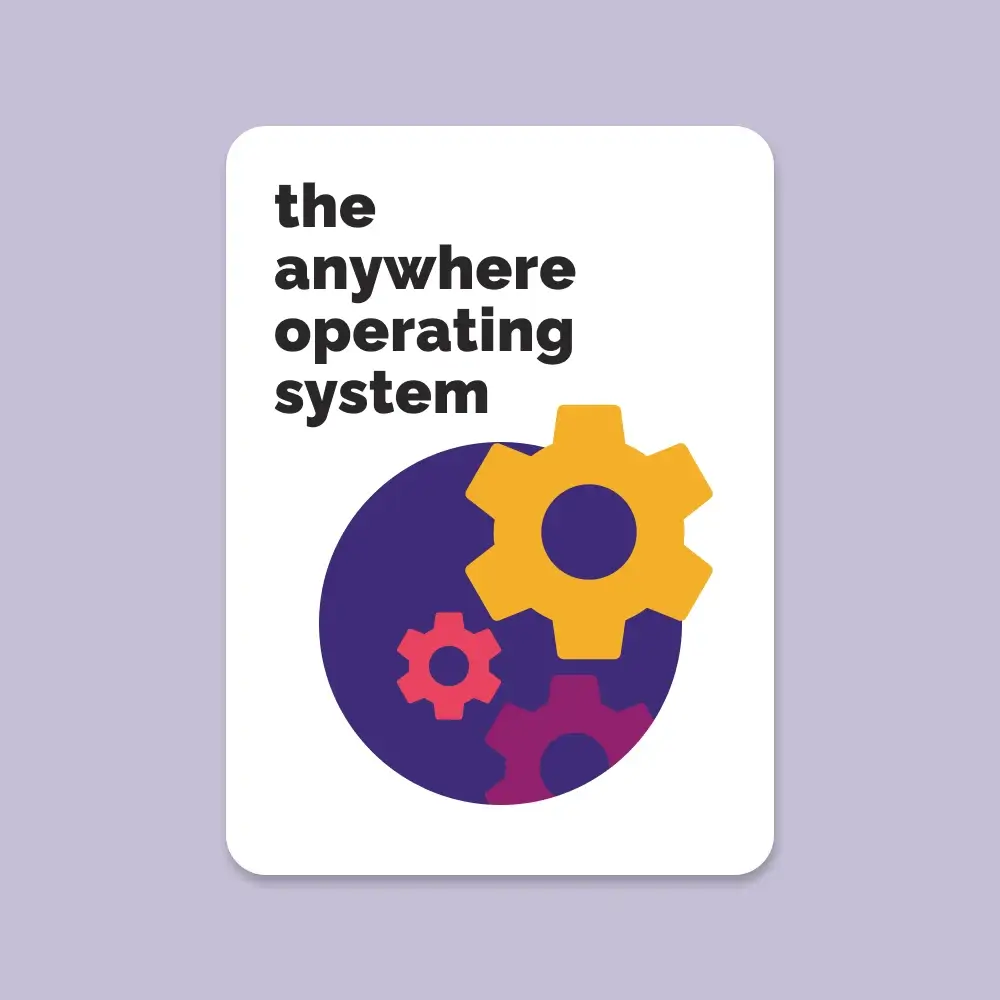
The Anywhere Operating System
-
It’s much easier to recruit if you give candidates a choice instead of forcing them to move. This is especially true if the potential hire has a spouse who works, a family, and roots in their community. It’s one thing to move as an individual; it’s another to move as a family.
-
When you work remotely, it’s easy to feel like you are missing out…because you are! This is the gap. It’s the difference between what you used to experience at the office and how you are feeling right now. You miss the context and awareness that you had at the office.
-
According to a FYI survey, people love remote work because it offers freedom, flexibility, no commute, and increased productivity. According to research from Buffer, the #1 benefit respondents cited was a flexible schedule.
“The most important contribution management needs to make in the 21st century is to increase the productivity of knowledge work and knowledge workers.” — Peter Drucker
“It demands that we impose the responsibility for their productivity on the individual workers themselves. Knowledge Workers have to manage themselves. They have to have autonomy.”
-
Everyone has different approaches when it comes to their personal productivity. Working a strict 9-5 p.m. schedule can be difficult for people who have different lifestyles and preferences. People are different. By allowing colleagues to work when they are most productive, the company as a whole can benefit.
-
Asynchronous communication is when two or more people communicate without the requirement that they be present at the same moment in time. For example, if I send you an email, you could read and reply at a time that makes sense for you. If I send you a handwritten letter in the mail, you can read it when it arrives, and reply at a time when it makes sense for you.
-
Asynchronous communication is a more flexible way to communicate because the sender and receiver don’t need to be present at the same time.
-
If you want to be successful from anywhere, you need to create a single source of truth for the most important stuff that everyone should know. Many people call this repository a company handbook.
-
This handbook aims to provides organizational context, which guides decision making, expected behavior, and helps the entire company level-up. If you don’t have a handbook, people will need to gather context over time (through trial and error), which is an epic waste of time and leads to alignment issues.
-
The key foundational principle to spending less time in meetings is simple: share written updates before you meet.
-
Remember that meetings are a tool in your toolbox — the goal here isn’t to eliminate all your meetings. It’s to have fewer, better meetings.
“Organizational culture is the pattern of basic assumptions that a given group has invented, discovered, or developed in learning to cope with its problems of external adaptation and internal integration, and that have worked well enough to be considered valid, and, therefore, to be taught to new members as the correct way to perceive, think, and feel in relation to those problems.”
- How to reinforce your values at work:
- Before you hire someone, you should ask questions based on your company values and determine if there’s alignment. You could also highlight these values on your company website and job pages.
- When you onboard someone new, you should reiterate these values right away
- Values should be front and center in your company handbook
- If you have an office, values could be displayed on the wall or a bulletin board
- When you do monthly reviews or quarterly planning, you should reiterate the company values
-
You should start by having every employee create a people profile. Think of this profile as a mashup of your LinkedIn and Facebook profile. The goal is to create context about who you are and how you like to work, which is especially important when you onboard new hires. These profiles build a bedrock of empathy and remind you that your coworkers are real people, not emotionless robots.
-
Instead of small talk at the beginning, you could start with work and then spend the rest of the time doing team building. Instead of spending 5% of meeting time hanging out, you should hang out 95% of the time instead.
-
Give people clear areas of ownership and don’t overcomplicate it. Often you hire people to solve one primary pain point. Make it obvious what the most important area of ownership is.
-
Make key responsibilities visible to all – Ideally, a new employee should be able to visit a coworker’s profile and see what they are responsible for. They shouldn’t need to ask around to learn this.
-
The #1 reason why your company should meet up in person at least once a year is because it’s the fastest way to recharge the “trust battery.” If you want to accelerate and build better relationships and trust with your coworkers, the fastest way to do it is by spending quality time together.
-
People will remember your company meetups for years to come, so make them count! Optimize for getting to know your team above getting work done. You have the rest of the year to work.
-
Hiring people you have never met in person may seem scary, but if you create a process and stick by it, you can dramatically reduce the potential downside.
-
The first and most important problem to solve is that you need to create structure to your day. You can’t rely on the commute to the office to help you ease into your work. You also don’t have observable signals at the office that encourage you to finish up your work and go home at a reasonable hour.
-
Don’t force a schedule. The point of having a flexible schedule is that it can be flexible. Having something too rigid could lead to burnout.
-
The work-from-anywhere movement isn’t about working from home. It’s not only about where you decide to work from, but it’s about when you work.
- If you plan on building healthy long-term working relationships, you need to constantly remind yourself that your coworkers have hobbies, interests, and career aspirations. The minute you feel your coworkers are emotionless robots is the minute your workplace relationships will start to deteriorate.

